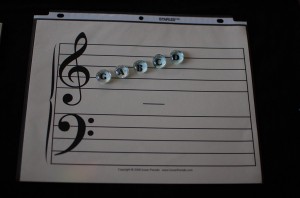Back in the fall we introduced the idea of Keyboard Geography: Looking at the keys and noticing the patterns made by black and white keys. The black keys are SO important because without them, you'd have no way to visually distinguish the C's or F's or any keys at all!
You can guess that eventually your pianist will want to play songs without looking at her hands much, but before she gets to that point it is valuable to spend some serious time now looking at, learning, and internalizing what the keyboard looks like. Eventually, she'll be able to hold the image of where her fingers are (and where they need to go next) in her mind's eye. Combining her mental image of the keyboard with her muscle memory (read about it here and here) she'll be able to play without looking down very often.
Visual and Kinesthetic Learning
In class, your child practices singing the musical alphabet to learn the pattern of the keys, and practices the Kit-Kat Keyboard chant to start practice matching the keys to the keyboard. Both of these activities are primarily aural but become a visual way of learning when keyboard matching comes into play. To strengthen the learning, we provide even more pathways (read about the learning process here) for mastering information by giving students kinesthetic ways to play with the skills.
Alphabet games help make drilling "what's the name of this key?" fun and engaging AND because they involve your child moving a tangible object over to a tangible key, this knowledge sticks better than if we only used flashcards.
Whenever possible, take it one step further by playing the pitch of the note after identifying the alphabet letter, and matching it…"Yes, that was a D, and a D sounds like this…DEEEE." We try to find ways to see it, hear it, and get physically involved as we practice it.
Where Do We Go Next?
Next fall your student will start learning to read every single note on the staff, and match each note to its exact key on the keyboard. Of course, it's going to be a very rough challenge if your child reads "treble D" off the staff but can't find a D on the keyboard. This is one reason we spend time on key names now; it's the prerequisite for advanced music reading.
I like to point out that the alphabet names of the notes and keys are an abstract concept created to help us read music. It IS possible and necessary to read music by matching "that note" with "that key" correctly without identifying the name of "that note". (Read more about it here)
But these key names are critical to give us the way to talk about the notes and keys and be specific as we teach the advanced theory coming next year (changing key signatures, transposing, adding sharps and flats, etc.)
Great Ways to Play
Now that you're motivated, you'll definitely want to check out the list of different games using alphabet pieces. (CLICK HERE). You'll see everything from Cowboys and Indians to Frogger and Go Fish: all games that will encourage visual matching and active learning.
Get Crafty
Now, for a crafty way to make your pieces the cutest and most gorgeous ever (also preventing them from falling between piano keys,) try this option: making Musical AlphaGems!
Materials
- Clear glass gems (each approx. 1/2 inch in diameter): avoid ones that are too big to fit on your piano key!
- Cardstock alphabet (last page of your Yellow Arrows songbook)
- Acrylic spray (option)
- Clear silicone adhesive (sticks well to glass and is less smelly than other strong glues)
- Workspace covered with some newspaper
- Scissors
Instructions
- Optional: Before cutting out the alphabet circles from the printable, spray the backside of the cardstock paper with a few coats of acrylic spray. This will help seal the paper and make your gems last longer.
- Using a pair of scissors, cut out alphabet circles to fit your gems. Too small is better than too big.
- Examine each glass gem before using to check for imperfections. Toss any that are chipped or have odd designs that might affect how easily you can read the alphabet letter through the glass.
- Put a dab of silicone glue on the bottom of a glass gem and then gently press the gem onto a cut-out circle so that the printed alphabet letter shows through the glass. Gently wipe the gem’s edges on the newspaper workspace to remove any excess glue. Allow the gems to dry upside down.
That's it! Go have some fun with your alphabet games.
-Gina Weibel, M.S.
* Musical AlphaGems was first seen at www.colorinmypiano.com
-Gina Weibel, M.S.
* Musical AlphaGems was first seen at www.colorinmypiano.com





No comments:
Post a Comment